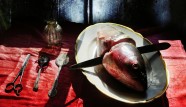Photos by a researcher from the Israel Institute for Biological Research have drawn large crowds at exhibits in New York, London and Herzaliya.
What makes Gilat’s “Life Science” photo series unique is not that the photographs were taken by a scientist or even that the images display biomedical content, but the incisive philosophical reflection that the photos offer.
Gilat’s “Life Science” photographs generally document artifacts comprising some form of tissue, organ or dead animal that is juxtaposed beside antique medical instruments and other objects, including food and naked bodies. Impeccably lit, the radically juxtaposed artifacts are laid out in a surprisingly orderly way — as though some kind of inexplicable medical experiment is about to take place.
Stunning in a beautiful, haunting and thought-provoking way, the photos have earned praise from critics such as Lucy Gallun, the curator of the Museum of Modern Art, who observed that they bring to mind the game piece vanitas genre of 17th century Dutch and Flemish painting. That genre, which includes works by painters such as Harmen Steenwyck, show objects such as food and hunted game rotting on lavish banquet tables. In doing so those painters put across a sobering message about the transience of the material world.
Gilat seems to have found a way to raise the same probing questions that the Renaissance painters asked but goes one step further by bringing in a biomedical dimension.
“Life Sciences” had its debut at the New York Photo Festival in May. According to Festival Director Sam Barzilay, the photos were “some of the most popular ones at the exhibit.”
The photos were subsequently exhibited in London at theFOTO8 London Gallery Summer Show and recently in Israel at the Herzliya Artists’ Residence Gallery in a show entitled “LaDa’at Chaim” curated by Varda Ginosar.
Dr. Eran Gilat, 59, did post-doctoral studies at New York’s Albert Einstein College of Medicine where he tried to unravel the neural system that enables the Venezuelan hatchetfish to jump to great heights in a nanosecond. Working at the Israel Institute for Biological Research he has spent three decades studying the mechanisms of epileptic activity and the cardio-vascular system. He has published extensively in journals such as Brain Research and Circulation. A collaboration with Prof. Gidi Eshel from Assaf Harofeh Medical Center led to a new therapy for epileptic children,.
As a photographer, Gilat actually began his career at an earlier age. He became an avid shutter bug at about 14 taking nature photographs on Kodak Ektachrome slide film. Most of the photography that Gilat has done in his spare time over the years has been in the genre of urban photography.
Then about three years ago, while Gilat was on sabbatical leave at the Case Western Reserve University in Cleveland, Ohio he made the decision to devote more time to art.
“Doing something with biological tissues is something that I always wanted to do,” he said in a recent interview.
Gilat’s images may be blunt and disquieting but they seem to ask deep questions in a refreshing way.
Is it really possible for researchers to disconnect their feelings while observing animal or human flesh? What are the borderlines between scientific examination and eroticism? What is it like for medical researchers to work in an environment that is filled with dead animals? Is there beauty in exposed flesh? At what point do tissues become repulsive and at what point do those same tissues become attractive as edible food?
When asked if he is trying to address some of these issues, Gilat points out that it is easier for him to discuss science than art.
But if he is reluctant to discuss the ways in which his art may be interpreted, he is outspoken about ways in which it may be misinterpreted. “We have to sacrifice rats and guinea pigs if we want to develop medical treatments,” he says, emphasizing that he is not an anti-vivisectionist. “But sometimes we have to give animal and human flesh more respect.”
He also stresses that all of the artifacts in his photographs are obtained from marketplaces, slaughterhouses or natural history facilities. “As a matter of principle, I don’t believe that animals should be sacrificed for the sake of art.”
In addition, he suggests that there could be an educational value to exposing medical students to his exhibits. “I recall from my training that medical students were expected to be able to walk into an operating room without much preparation. Maybe this could be a way of softening the transition.”
Bernard Dichek


